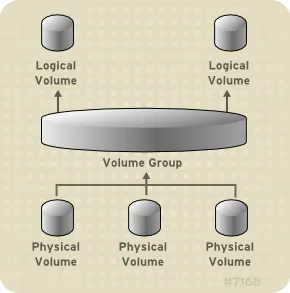A volume group (VG) is the central unit of the Logical Volume Manager (LVM) architecture. It is what we create when we combine multiple physical volumes to create a single storage structure, equal to the storage capacity of the combined physical devices. Physical volumes are devices that are initialized using LVM, i.e., hard disk drives, solid-state drives, partitions, etc.

When we take two 1Gb physical volumes and create a volume group, we end up with a consolidated storage capacity of 2Gb. Now that we have a basic understanding of what a volume group is, let's take a look at how to create and configure these in Linux. I will be using Red Hat Enterprise Linux 8 for the following examples.
[root@rhel ~]# pvs
PV VG Fmt Attr PSize PFree
/dev/sda2 rhel lvm2 a-- <29.00g 0
/dev/sdb lvm2 --- 1.00g 1.00g
/dev/sdc lvm2 --- 1.00g 1.00g>
You will notice that /dev/sdb and /dev/sdc are initialized as physical volumes but do not belong to a Volume Group (whereas /dev/sda2 belongs to the volume group rhel).
[ Want to test your sysadmin skills? Take a skills assessment today. ]
Group creation
Ok, now that we have nailed down the "what and why," let's configure a volume group using the two physical volumes illustrated above. You can see the creation and initialization of these groups in my article, How to create physical volumes in Linux using LVM.
We are going to combine /dev/sdb and /dev/sdc into a volume group. First, we will need to name the group. For test purposes, I will call our group LVMvgTEST. Now that we have decided on a name, let's use a single command to add both physical volumes to the new volume group. This command needs to be run as root or with sudo.
[root@rhel ~]# vgcreate LVMvgTEST /dev/sdb /dev/sdc
Volume group "LVMvgTEST" successfully created
You can see in the output that the volume group was successfully created. Now we can use the pvs command to see the change to our storage architecture.
[root@rhel ~]# pvs
PV VG Fmt Attr PSize PFree
/dev/sda2 rhel lvm2 a-- <29.00g 0
/dev/sdb LVMvgTEST lvm2 a-- 1020.00m 1020.00m
/dev/sdc LVMvgTEST lvm2 a-- 1020.00m 1020.00m
Now you can see that /dev/sdb and /dev/sbc are a part of our LVMvgTEST volume group.
Next steps…
Congratulations on the volume group creation! If you're thinking, "Well, what now?" I recommend that you continue exploring LVM and use lvcreate to create logical volumes. There are many ways to do this, so do your research! I will cover these in a future article, so keep an eye out for that!
[ Free online course: Red Hat Enterprise Linux technical overview. ]
About the author
Tyler is the Sr. Community Manager at Enable Sysadmin, a submarine veteran, and an all-round tech enthusiast! He was first introduced to Red Hat in 2012 by way of a Red Hat Enterprise Linux-based combat system inside the USS Georgia Missile Control Center. Now that he has surfaced, he lives with his wife and son near Raleigh, where he worked as a data storage engineer before finding his way to the Red Hat team. He has written numerous technical documents, from military procedures to knowledgebase articles and even some training curricula. In his free time, he blends a passion for hiking, climbing, and bushcraft with video games and computer building. He is loves to read and enjoy a scotch or bourbon. Find him on Twitter or on LinkedIn.
Browse by channel
Automation
The latest on IT automation for tech, teams, and environments
Artificial intelligence
Updates on the platforms that free customers to run AI workloads anywhere
Open hybrid cloud
Explore how we build a more flexible future with hybrid cloud
Security
The latest on how we reduce risks across environments and technologies
Edge computing
Updates on the platforms that simplify operations at the edge
Infrastructure
The latest on the world’s leading enterprise Linux platform
Applications
Inside our solutions to the toughest application challenges
Original shows
Entertaining stories from the makers and leaders in enterprise tech
Products
- Red Hat Enterprise Linux
- Red Hat OpenShift
- Red Hat Ansible Automation Platform
- Cloud services
- See all products
Tools
- Training and certification
- My account
- Customer support
- Developer resources
- Find a partner
- Red Hat Ecosystem Catalog
- Red Hat value calculator
- Documentation
Try, buy, & sell
Communicate
About Red Hat
We’re the world’s leading provider of enterprise open source solutions—including Linux, cloud, container, and Kubernetes. We deliver hardened solutions that make it easier for enterprises to work across platforms and environments, from the core datacenter to the network edge.
Select a language
Red Hat legal and privacy links
- About Red Hat
- Jobs
- Events
- Locations
- Contact Red Hat
- Red Hat Blog
- Diversity, equity, and inclusion
- Cool Stuff Store
- Red Hat Summit

